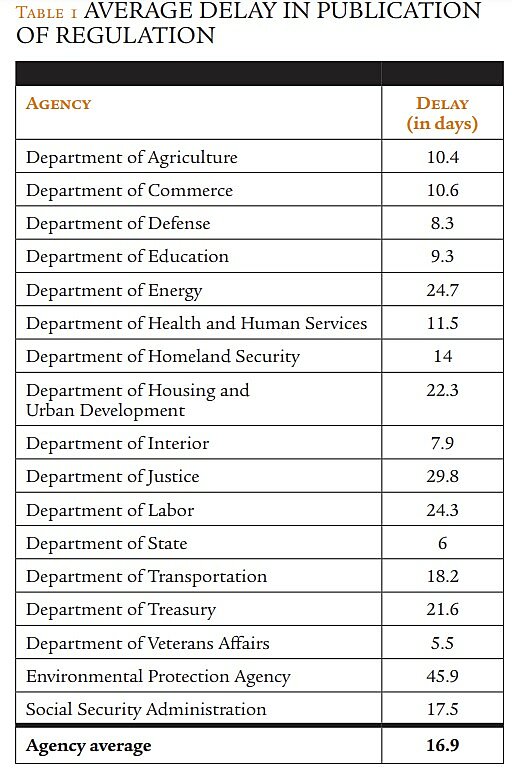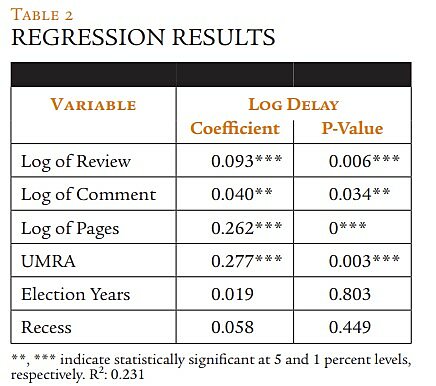This ultimate step does not entail any complicated procedure. In the aftermath of the September 11, 2001, terrorist attacks, when the regulatory state was moving with uncommon alacrity to ensure that copycat hijackings never occurred, regulations issued by a federal agency would get published within hours of being approved by the White House’s Office of Information and Regulatory Affairs (OIRA).
However, that is far from customary. These days, regulations that have garnered the OIRA imprimatur can languish for weeks or even months before appearing in the Federal Register. For instance, in April 2014, Sen. James Inhofe (R‑Okla.) speculated that the U.S. Environmental Protection Agency intentionally delayed the publication date of its greenhouse gas standards for new power plants in order to avoid a vote under the Congressional Review Act until after the fall elections. According to Senator Inhofe, the EPA intentionally held the proposal for 66 days.
There has been extensive research attempting to discern the magnitude and cause of the delays that federal agencies face as they navigate the regulatory process. Few dispute the notion that more expensive and controversial regulations invite greater scrutiny during the interagency review process, lengthening the time it takes for such regulations to get OIRA approval. However, less effort has gone into determining what affects the fate of rulemakings after the new rules leave OIRA. Is there something else besides sheer politics that causes an administration to delay the formal publication of a rule that has survived its regulatory process?
Strategic delay / In order to answer the question of why regulations face lengthy publication delays after OIRA review, we examined all major and “economically significant” final rules (those that have an economic effect of greater than $100 million annually) published between August 2004 and August 2014. That constitutes a total of 491 rules from 17 cabinet agencies.
We compared this “publication delay” to several independent variables: the length of the OIRA review, the number of comments received, and status under the Unfunded Mandates Reform Act (UMRA), which we used as a proxy to indicate whether the rule imposes significant compliance costs. We also included the number of pages the rule ultimately took up in the Federal Register when published, which we interpreted as a proxy for complexity, and whether the rule was published during a congressional recess or in an election year. As we previously pointed out in these pages, rulemaking tends to speed up markedly during presidential election years, regardless of the party in power (“No ‘Midnight’ after this Election,” Spring 2013).
As shown in Table 1, the average delay between approval and publication in our sample was just under 17 days, but there was a high degree of variation between agencies. Not surprisingly, the EPA easily outpaced all other agencies, with an average publication delay of 45.9 days—more than double the overall average. Former OIRA official and current Rutgers University professor Stuart Shapiro opined that the delay is clearly strategic: “Because the EPA has the most controversial rules, it has the most need for strategic timing with the release of its rules.” On the other end of the spectrum, the Departments of State and Veterans Affairs made haste whenever OIRA approved their major rules, with publication delays of merely 6 and 5.5 days.



